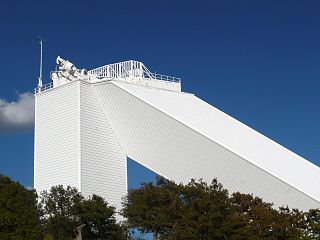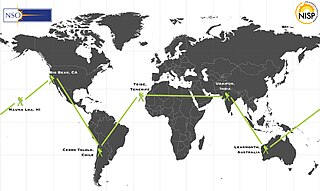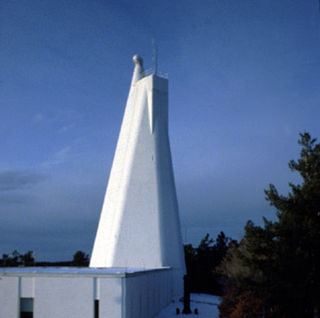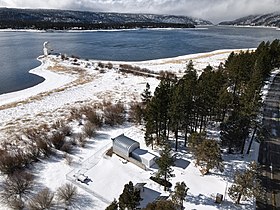The National Solar Observatory (NSO) is a United States federally funded research and development center to advance the knowledge of the physics of the Sun. NSO studies the Sun both as an astronomical object and as the dominant external influence on Earth. NSO is headquartered in Boulder and operates facilities at a number of locations - at the 4-meter Daniel K. Inouye Solar Telescope in the Haleakala Observatory on the island of Maui, at Sacramento Peak near Sunspot in New Mexico, and six sites around the world for the Global Oscillations Network Group one of which is shared with the Synoptic Optical Long-term Investigations of the Sun.

The Gemini Observatory comprises two 8.1-metre (26.6 ft) telescopes, Gemini North and Gemini South, situated in Hawaii and Chile, respectively. These twin telescopes offer extensive coverage of the northern and southern skies and rank among the most advanced optical/infrared telescopes available to astronomers. (See List of largest optical reflecting telescopes).

The National Optical Astronomy Observatory (NOAO) was the United States national observatory for ground-based nighttime ultraviolet-optical-infrared (OUVIR) astronomy. The National Science Foundation (NSF) funded NOAO to provide forefront astronomical research facilities for US astronomers. Professional astronomers from any country in the world could apply to use the telescopes operated by NOAO under the NSF's "open skies" policy.

The Swedish 1-m Solar Telescope is a refracting solar telescope at Roque de los Muchachos Observatory, La Palma in the Canary Islands. It is run by the Institute for Solar Physics of Stockholm University. The primary element is a single fused silica lens, making it the largest optical refracting telescope in use in the world. The Swedish 1-m Solar Telescope, with a lens diameter of 43 inches, is technically larger than Yerkes Observatory, only 39 inches are clear for the aperture.The SST is most often used as a Schupmann telescope, thereby correcting the chromatic aberrations of the singlet primary.

Transition Region and Coronal Explorer was a NASA heliophysics and solar observatory designed to investigate the connections between fine-scale magnetic fields and the associated plasma structures on the Sun by providing high resolution images and observation of the solar photosphere, the transition region, and the solar corona. A main focus of the TRACE instrument is the fine structure of coronal loops low in the solar atmosphere. TRACE is the third spacecraft in the Small Explorer program, launched on 2 April 1998, and obtained its last science image on 21 June 2010, at 23:56 UTC.

McMath–Pierce solar telescope is a 1.6 m f/54 reflecting solar telescope at Kitt Peak National Observatory in Arizona, United States. Built in 1962, the building was designed by American architect Myron Goldsmith and Bangladeshi-American structural engineer Fazlur Rahman Khan. It was the largest solar telescope and the largest unobstructed aperture optical telescope in the world. It is named after the astronomers Robert Raynolds McMath and Keith Pierce.

The Global Oscillation Network Group (GONG) is a worldwide network of six identical telescopes, designed to have 24/7 observations of the Sun. The network serves multiple purposes, including the provision of operation data for use in space weather prediction, and the study of solar internal structure and dynamics using helioseismology.

Teide Observatory, IAU code 954, is an astronomical observatory on Mount Teide at 2,390 metres (7,840 ft), located on Tenerife, Spain. It has been operated by the Instituto de Astrofísica de Canarias since its inauguration in 1964. It became one of the first major international observatories, attracting telescopes from different countries around the world because of the good astronomical seeing conditions. Later, the emphasis for optical telescopes shifted more towards Roque de los Muchachos Observatory on La Palma.

The Kodaikanal Solar Observatory is a solar observatory owned and operated by the Indian Institute of Astrophysics. It is on the southern tip of the Palani Hills 4 kilometres (2.5 mi) from Kodaikanal.
Solar physics is the branch of astrophysics that specializes in the study of the Sun. It deals with detailed measurements that are possible only for our closest star. It intersects with many disciplines of pure physics, astrophysics, and computer science, including fluid dynamics, plasma physics including magnetohydrodynamics, seismology, particle physics, atomic physics, nuclear physics, stellar evolution, space physics, spectroscopy, radiative transfer, applied optics, signal processing, computer vision, computational physics, stellar physics and solar astronomy.

The Dunn Solar Telescope also known as the Richard B. Dunn Solar Telescope is a unique vertical-axis solar telescope, in Sunspot, New Mexico located at Sacramento Peak, New Mexico. It is the main telescope at the Sunspot Solar Observatory, operated by New Mexico State University in partnership with the National Solar Observatory through funding by the National Science Foundation, the state of New Mexico and private funds from other partners. The Dunn Solar Telescope specializes in high-resolution imaging and spectroscopy to help astrophysicists worldwide obtain a better understanding of how the Sun affects the Earth. Completed in 1969, it was upgraded with high-order adaptive optics in 2004 and remains a highly versatile astrophysical observatory which serves as an important test platform for developing new instrumentation and technologies. The Dunn Solar Telescope, located in Sunspot, New Mexico, is a vertical-axis solar telescope that specializes in high-resolution imaging and spectroscopy. It was completed in 1969 and received a significant upgrade with high-order adaptive optics in 2004.

Big Bear Solar Observatory (BBSO) is a university-based solar observatory in the United States. It is operated by New Jersey Institute of Technology (NJIT). BBSO has a 1.6-meter (5.2 ft) clear aperture Goode Solar Telescope (GST), which has no obscuration in the optical train. BBSO is located on the north side of Big Bear Lake in the San Bernardino Mountains of southwestern San Bernardino County, California, U.S., approximately 120 kilometers (75 mi) east of downtown Los Angeles. The telescopes and instruments at the observatory are designed and employed specifically for studying the activities and phenomena of the Sun.
The UCL Mullard Space Science Laboratory (MSSL) is the United Kingdom's largest university space research group. MSSL is part of the Department of Space and Climate Physics at University College London (UCL), one of the first universities in the world to conduct space research. Since its establishment, MSSL has participated in 35 satellite missions, 10 of which are currently in operation, and in over 200 sounding rocket experiments.
A vector magnetograph is a type of imaging telescope that can estimate the 3-D vector of the magnetic field on a distant body with a resolved line spectrum. Magnetographs are useful for studying the Sun because the surface magnetic field is important to the creation and maintenance of the solar corona, and gives rise to the phenomena of solar flares and space weather.

The Daniel K. Inouye Solar Telescope (DKIST) is a scientific facility for studies of the Sun at Haleakala Observatory on the Hawaiian island of Maui. Known as the Advanced Technology Solar Telescope (ATST) until 2013, it was named after Daniel K. Inouye, a US Senator for Hawaii. It is the world's largest solar telescope, with a 4-meter aperture. The DKIST is funded by National Science Foundation and managed by the National Solar Observatory. The total project cost is $344.13 million. It is a collaboration of numerous research institutions. Some test images were released in January 2020. The end of construction and transition into scientific observations was announced in November 2021.
The Sunrise balloon-borne solar observatory consists of a 1m aperture Gregory telescope, a UV filter imager, an imaging vector polarimeter, an image stabilization system and further infrastructure. The first science flight of Sunrise yielded high-quality data that reveal the structure, dynamics and evolution of solar convection, oscillations and magnetic fields at a resolution of around 100 km in the quiet Sun.

The Nicholas U. Mayall Telescope, also known as the Mayall 4-meter Telescope, is a four-meter reflector telescope located at the Kitt Peak National Observatory in Arizona and named after Nicholas U. Mayall. It saw first light on February 27, 1973, and was the second-largest telescope in the world at that time. Initial observers included David Crawford, Nicholas Mayall, and Arthur Hoag. It was dedicated on June 20, 1973 after Mayall's retirement as director. The mirror has an f/2.7 hyperboloidal shape. It is made from a two-foot thick fused quartz disk that is supported in an advanced-design mirror cell. The prime focus has a field of view six times larger than that of the Hale reflector. It is host to the Dark Energy Spectroscopic Instrument. The identical Víctor M. Blanco Telescope was later built at Cerro Tololo Inter-American Observatory, in Chile.

Philip R. Goode is an American theoretical physicist also working in observational astronomy and its instrumentation. He is a Distinguished Research Professor of Physics at New Jersey Institute of Technology (NJIT) with an H-index > 60. His career divides into five overlapping periods as follows:

















